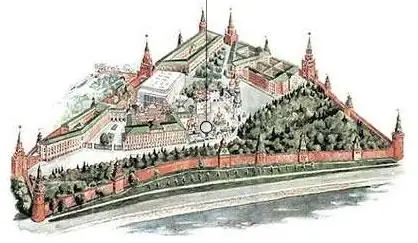- Author Harold Hamphrey [email protected].
- Public 2023-12-17 10:06.
- Last modified 2025-01-24 11:10.
The theater square in Saratov has existed since 1812, it received the official name "Khlebnaya" when a new master plan for development was approved after a big fire. One of the three retail areas, it quickly acquired two-story buildings. Shops and shops were located on the first floors, merchants' offices were located on the second floors.
Khlebnaya Square differs from its contemporaries in that it has experienced not only a multiple change in appearance, but also a large number of renames.
Teatralnaya Square in Saratov
In 1815, on the southern outskirts of the vast territory of Khlebnaya Square, a wooden theater was built, which gave the name to this part of it. At the end of the 19th century, the Radishchev Art Museum was opened opposite the theater. And until the end of the century, the southern part was no longer built up with any structures. But the remaining ¾ had a dense development of retailrows, hotels, banks. This part of the square was officially called the Trade Square, but the people called it the Upper Market.
After the theater building was not enough to receive everyone, and the new one built instead of it, but also wooden, burned down, it was decided to build a large stone theater.
City Theater
The Saratov society applied for the highest permission to use state money for the construction of a theater building. It was allowed to spend 40 thousand rubles, as a result, the theater cost the city twice as much.
Among those wishing to rent the theater, the city authorities have chosen the merchant Osip Shekhtel, the father of the future famous architect. The first performance took place in the autumn of 1865. The authorities demanded from local and visiting troupes that not only drama performances, concerts and dance numbers, but also operas be shown on the stage.

After the revolution, the theater on Saratov's Theater Square became an opera house. His repertoire included the best works of opera and ballet. The Drama Theater was opened in a different location.
In the middle of the 20th century, a major reconstruction of the building was carried out. In fact, instead of an already dilapidated building, a modern palace was built that met all the requirements of that time. A number of famous artists are known who at certain stages of their lives worked on the Saratov stage. These are Vatslav Dvorzhetsky, Oleg Yankovsky, Evgeny Mironov and many, many others.
Museum named after A. N. Radishchev
In the second half of the XIX century inPublic museums began to appear in Russia, the purpose of which was to bring knowledge to the people. In 1852, the Hermitage was opened in St. Petersburg, 15 years later Moscow followed suit, creating the Tretyakov Gallery. Famous artist, professor, collector and grandson of A. N. Radishcheva Alexey Petrovich Bogolyubov promised the Saratov authorities to bequeath his collection to the city, but on condition that a large and comfortable building be built for it.

In the summer of 1885, the Radishchev Art Museum was opened on Theater Square in Saratov, the third public museum in Russia and the first in the provinces.
Revolution Square, Theater Square
During the years of Soviet power, the Upper Bazaar with all its buildings was demolished, and in its place a huge wasteland was formed, which in 1920 was named Revolution Square. A mass grave of soldiers of the Red Army appeared in front of the theater building; stone, surviving buildings of shopping arcades began to be used for the needs of the city. Various institutions, a printing house, a garment factory were located here. In the seventies, a new building of the Research Institute was built, a little later - the Regional Executive Committee. At the same time, a monument to V. I. Lenin was erected here, and the square became fully consistent with its name.
During its improvement in the 50s, a small park was laid out, a monument was erected on the mass grave and the Eternal Flame was lit. All city festive demonstrations and rallies were held on Revolution Square, where temporary stands were installed.

In 1991, the territory in the centerThe city was again renamed the Theater Square of Saratov, the address of which is known to every Saratov. Guests can be guided by the fact that it is located between Moskovskaya street, Radishcheva and Gorkogo.

Currently, the square remains the site of city holidays. Mandatory parades in honor of Victory Day, mass events for City Day, sports competitions, and concerts are held here. Seasonal fairs and New Year's festivities are also held here. At the end of the 20th century, the chapel of Alexander Nevsky "The Life-Giving Spring" was built on Theater Square in Saratov. It was installed on the site of the destroyed chapel of the same name, which was erected in 1866 in honor of Emperor Alexander.






